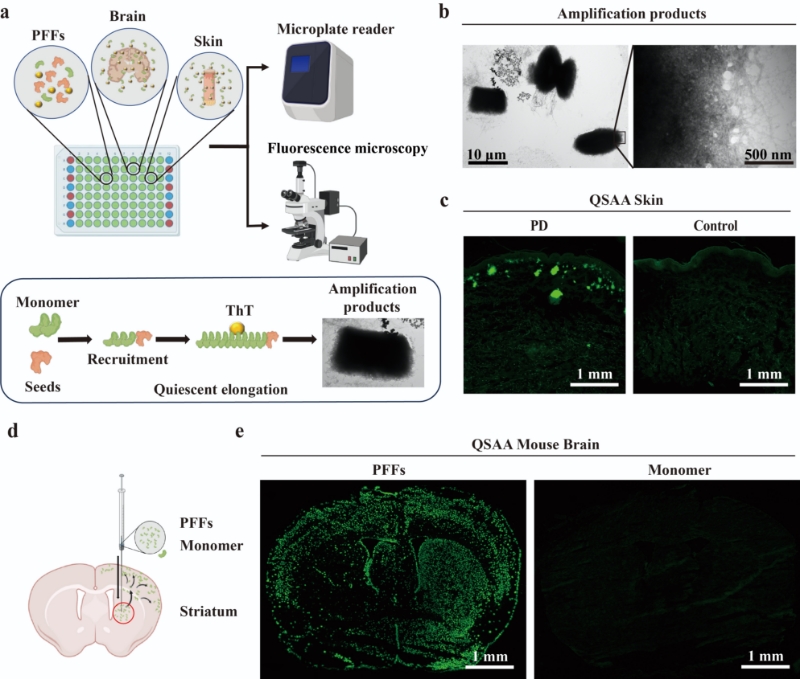Category: Technology
Objective: To develop a technology capable of ultra-sensitive, in situ amplification of abnormal conformations of αSyn within biological samples, potentially enhancing diagnostic accuracy and shedding light on disease progression mechanisms.
Background: The α-synuclein (αSyn) seed amplification assay (SAA) represents a promising approach for identifying αSyn aggregates, serving as an indicator for Lewy body pathology. This process involves repetitive cycles of shaking or sonication to facilitate the detection of abnormal proteins. However, this amplification approach faces limitations in tracking protein propagation due to frequent fragmentation.
Method: We employed a modified version of SAA, termed quiescent SAA (QSAA), to blindly examine biopsy samples obtained from pathologically confirmed brain biopsy samples from 14 subjects with PD and 6 subjects with nonsynucleinopathies. Additionally, clinically diagnosed skin samples were selected from 214 patients with PD and 208 controls without PD.
Results: We have developed a novel αSyn quiescent SAA, named QSAA, which effectively detects αSyn pathology in tissue sections (in situ) without requiring shaking or sonication. This assay allows for the visualization of the deposition and spread of pathological αSyn throughout the brain in PD. Furthermore, in a blind study involving biopsy brain and skin tissues from PD patients, in situ QSAA exhibited exceptional sensitivity (100%) and specificity (100%) in brain samples from 14 PD and 6 non-PD cases within a 24-hour timeframe. QSAA also accurately differentiated PD patients from non-PD controls, demonstrating an overall sensitivity of 90.2% and specificity of 91.4% in biopsy skin samples from 214 PD patients and 208 controls within 24 hours. These results highlight the promising mechanistic insights and diagnostic potential of QSAA for the pre-mortem assessment of suspected PD.
Conclusion: Brain and dermal QSAA proves to be a highly sensitive method for detecting αSyn aggregation in PD. This technique enables the in situ amplification of αSyn aggregates while preserving tissue integrity, making it well-suited for investigating the pathogenesis and spread of PD using both brain and skin samples. QSAA could be regarded as a valuable adjunctive procedure for diagnosing PD.
figure 1 QSAA
To cite this abstract in AMA style:
H. Mao, Y. Kuang, P. Xu. Ultrasensitive detection of aggregated α-synuclein using quiescent seed amplification assay for the diagnosis of Parkinson’s Disease [abstract]. Mov Disord. 2024; 39 (suppl 1). https://www.mdsabstracts.org/abstract/ultrasensitive-detection-of-aggregated-%ce%b1-synuclein-using-quiescent-seed-amplification-assay-for-the-diagnosis-of-parkinsons-disease/. Accessed December 29, 2025.« Back to 2024 International Congress
MDS Abstracts - https://www.mdsabstracts.org/abstract/ultrasensitive-detection-of-aggregated-%ce%b1-synuclein-using-quiescent-seed-amplification-assay-for-the-diagnosis-of-parkinsons-disease/

